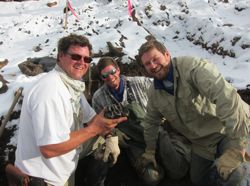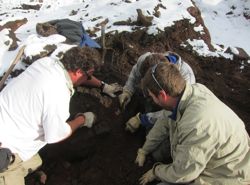Mastodon Found in the Rockies
Air Date: Week of December 17, 2010
 |
People in the Rocky Mountain west are accustomed to finding treasure in the ground — gold, silver, oil & gas. But outside the ski mecca of Snowmass Village, archaeologists struck a rich vein of another kind. Mitzi Rapkin reports.
Transcript
CURWOOD: Snowmass Village, Colorado, is perhaps best known as a first-class ski resort high in the Rocky Mountains. But soon, it could also become known for one of the most significant finds of ice age fossils in North America. From Aspen Public Radio, Mitzi Rapkin reports on the bounty of bones.
RAPKIN: Winter has arrived in Snowmass Village and with it, deep snow. But, researchers look forward to spring when they will return to an excavation site that riveted paleontologists and the just plain curious around the country.
TV NEWS ANCHOR: Scientists are calling it one of the most important and most exciting fossil finds ever in Colorado, already…
RAPKIN: The discovery includes nearly 600 bones so far. In this area that used to be mined for silver, the dig site is a fossil mother load.
MILLER: Columbian mammoth, American mastodon, uh, giant ground sloth, bison, tiger salamander. I’m missing one, oh and a deer.
RAPKIN: That’s Ian Miller, curator of paleontology at the Denver Museum of Nature and Science. It’s not necessarily unique to find so many ice age fossils in one place, but remains of these animals have never been found at such high altitude, or with such diversity, in the Rocky Mountains. Miller:

Left to right Kirk Johnson, Dane Miller and Ian Miller unearth the latest find at the Snowmass mother lode. (Photo Mitzi Rapkin)
MILLER: So, there’s no record of what was living here so we’ve been inferring what was living here at high elevation from other places. So it’s so great to have this Pleistocene graveyard at nine thousand feet. It’s really giving us some insight into what Colorado was like say 40, 50 thousand years ago.
RAPKIN: This ice age graveyard is geologically special, which likely accounts for the diversity of large mammals and the time period they represent. It’s an old lake that scientists estimate was formed 120 thousand years ago. It sits on top of a ridge, so it filled in slowly and wasn’t destroyed by subsequent glaciers.
These discoveries were a fluke. That ancient lake is now a municipal reservoir that happened to be under construction. Jessie Steele was running the yellow iron – that’s what he calls his bulldozer – when he noticed something unusual.
STEELE: There was two rib bones that come up in the dirt on the dozer to start with and as soon as I shut down and got out, I noticed there was a considerable amount more. I’m an avid hunter also, and so I could tell right away they waw ribs. I did not know what in the world they was off of…
RAPKIN: You knew it wasn’t a deer?
STEELE: No ma’am, it was not.
RAPKIN: From the day Steele found the ribs it was non-stop action at the site. More than 40 people dug at a time. The site also had 24-hour security to protect it from looters.
Kirk Johnson is the Chief Curator of the Denver Museum of Nature and Science, which is in charge of the excavation. The site is so rich with bones, his crew practically finds them on demand for visitors.
[DIGGING SOUNDS]

Left to right museum chief curator Kirk Johnson, excavator Dane Miller and curator Ian Miller with the tooth of an American mastodon. (Photo Mitzi Rapkin)
JOHNSON: There’s got to be a bone, here.
MAN 1:It looks like a tooth! Oh yea, it is…
MAN 2:it looks like it’s attached to the jaw here…it could be the mandible. Or, maybe it’s the skull.
JOHNSON: So this is like four by two and a half inches, about a pound, one tooth off an American Mastodon.
RAPKIN: Johnson says the fossils are in exquisite condition.
JOHNSON: We’re getting leaves that are still green. We’re getting beautiful preservation of the bones. The wood that comes out of the ground looks like driftwood, we’re finding chunks of beaver chewed sticks, and cones of spruce and fir, skeletons of little salamanders. So it’s a real well-preserved fossil treasure trove.
RAPKIN: It will take at least a year to slowly dry out the bones so they don’t disintegrate. They’ll still be drying when scientists return to the site in May to continue excavating. Now the town is trying to figure out how to market the find to draw tourists. The town council even adopted an official song, Big Wooly Mammoth. Many, including Johnson, also say it’s time for a name change in the town…
JOHNSON: They’ve got to change the name of this town. Snowmass is boring, Snowmastodon is accurate.
RAPKIN: For Living on Earth, I’m Mitzi Rapkin in Snowmass Village, Colorado.
CURWOOD: And if you’re curious what those bones look like, you can see one massive mastodon tooth at our website, L-O-E dot ORG.
Links
Living on Earth wants to hear from you!
Living on Earth
62 Calef Highway, Suite 212
Lee, NH 03861
Telephone: 617-287-4121
E-mail: comments@loe.org
Newsletter [Click here]
Donate to Living on Earth!
Living on Earth is an independent media program and relies entirely on contributions from listeners and institutions supporting public service. Please donate now to preserve an independent environmental voice.
NewsletterLiving on Earth offers a weekly delivery of the show's rundown to your mailbox. Sign up for our newsletter today!
 Sailors For The Sea: Be the change you want to sea.
Sailors For The Sea: Be the change you want to sea.
 The Grantham Foundation for the Protection of the Environment: Committed to protecting and improving the health of the global environment.
The Grantham Foundation for the Protection of the Environment: Committed to protecting and improving the health of the global environment.
 Contribute to Living on Earth and receive, as our gift to you, an archival print of one of Mark Seth Lender's extraordinary wildlife photographs. Follow the link to see Mark's current collection of photographs.
Contribute to Living on Earth and receive, as our gift to you, an archival print of one of Mark Seth Lender's extraordinary wildlife photographs. Follow the link to see Mark's current collection of photographs.
 Buy a signed copy of Mark Seth Lender's book Smeagull the Seagull & support Living on Earth
Buy a signed copy of Mark Seth Lender's book Smeagull the Seagull & support Living on Earth

